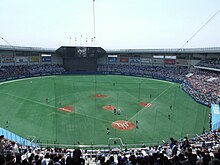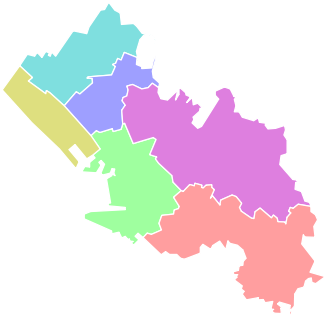Chiba (city): Difference between revisions
Closedmouth (talk | contribs) m Reverted edit(s) by 108.220.184.174 identified as test/vandalism using STiki |
Added/revised early history |
||
| Line 40: | Line 40: | ||
== History == |
== History == |
||
| ⚫ | |||
===Early history=== |
|||
In the [[Heian period]], the first records related to the city of Chiba record the emigration of [[Taira Tsuneshige]] (平常重) to [[Chiba Prefecture|Chiba]]. He proclaimed himself "[[Chiba no Suke]]" (千葉介) and governed around the region we know as Chiba city today. His descendants claimed the family name of "[[Chiba clan|Chiba]]" and continued dominance of this region until the [[Muromachi period]]. In the [[Kamakura period]], [[Chiba Tsunetane]] (千葉常胤) helped [[Minamoto Yoritomo]] (源頼朝) establish the [[Kamakura shogunate|Kamakura Bakufu]]. This made the [[Chiba clan]] important in the [[Kamakura shogunate|Kamakura Bakufu]]. He built [[Inohana castle]] on [[Inohana mountain]] and moved his headquarters to it from [[Oohji castle]]. |
|||
The first records related to the city of Chiba record the emigration of [[Taira Tsuneshige]] (1083?–1088), a powerful ''[[Samurai|bushi]]'' warlord of the late [[Heian period]], to [[Shimōsa Province]], which historically occupied the north of Chiba Prefecture. Tsuneshige was appointed as ''[[gunji]]'' administrator of [[Sōma District, Chiba|Sōma District]], but was transferred to the same position in [[Chiba District, Chiba|Chiba District]] two years later. Here he proclaimed himself {{Nihongo|Chiba Tsuneshige|千葉常重}}, became a [[kokushi]] governor of the province, and used the area around present-day Chiba City as a power base to rule over Shimōsa Province, [[Kazusa Province]], as well as establish himself as a military force in the [[Kantō Region]]. Tsuneshige was instrumental in aiding [[Minamoto Yoritomo]] (1147–1199) with the establishment of the [[Kamakura shogunate]]. Tsuneshige built a spacious residence and numerous temples in present-day Chiba City, and in the same period he transferred his power base from [[Ōji Castle]] to [[Inohana Castle]] on [[Mount Inohana]]. The clan's power extended in the region until the [[Muromachi period]].<ref>{{cite encyclopedia | encyclopedia = Encyclopedia of Japan | title = Chiba | url = http://rekishi.jkn21.com/ | accessdate = 2012-02-27 | year = 2012 | publisher = Shogakukan | location = Tokyo}}</ref> |
|||
| ⚫ | |||
===Medieval period=== |
|||
| ⚫ | The Chiba clan's power and influence declined because of wars around the [[Kantō region]] during the [[Nanboku-cho]] and [[Muromachi period]]s. In the 16th century, instead of the [[Chiba clan]], the [[Hara clan]], which was one of the servants of [[Chiba clan]], wielded power in this region. In the [[Sengoku period]], the [[Hara clan]] was forcibly removed by Yoshiaki Ashikaga (足利義明, not to be confused with [[Ashikaga Yoshiaki|足利義昭]]). Then, Yoshiaki Ashikaga was also removed by the Sakai (酒井 not to be confused with the [[Sakai clan]] in [[Mikawa Province|Mikawa]]) clan, which was one of the servants of the [[Satomi clan|Satomi]] (里見) clan. Finally both the [[Chiba clan|Chiba]] and Sakai clans were annihilated by [[Toyotomi Hideyoshi]]. |
||
===Later history=== |
|||
In the [[Edo period]], both the [[Oyumi clan|Oyumi]] (生実) ([[Morikawa clan|Morikawa]] (森川)) clan and the [[Sakura clan|Sakura]] (佐倉) clan governed the region. A part of the region was governed directly by the [[Tokugawa shogunate|Tokugawa Bakufu]]. The [[Oyumi clan]] governed their territory stably. On the other hand, according to the [[Sakura]] clan, in the beginning of the [[Edo period]], the governor was frequently changed by various events, such as [[Takeda Nobuyoshi]] (武田信吉), [[Matsudaira Tadateru]] (松平忠輝). [[Ogasawara Yoshitsugu]] (小笠原吉次), [[Doi Toshikatsu]] (土井利勝) and so on. Finally the [[Hotta]] (堀田) clan stably governed their territory. |
In the [[Edo period]], both the [[Oyumi clan|Oyumi]] (生実) ([[Morikawa clan|Morikawa]] (森川)) clan and the [[Sakura clan|Sakura]] (佐倉) clan governed the region. A part of the region was governed directly by the [[Tokugawa shogunate|Tokugawa Bakufu]]. The [[Oyumi clan]] governed their territory stably. On the other hand, according to the [[Sakura]] clan, in the beginning of the [[Edo period]], the governor was frequently changed by various events, such as [[Takeda Nobuyoshi]] (武田信吉), [[Matsudaira Tadateru]] (松平忠輝). [[Ogasawara Yoshitsugu]] (小笠原吉次), [[Doi Toshikatsu]] (土井利勝) and so on. Finally the [[Hotta]] (堀田) clan stably governed their territory. |
||
| ⚫ | |||
== Demographics == |
== Demographics == |
||
Revision as of 18:45, 27 February 2012
This article needs additional citations for verification. (February 2009) |
Template:Japanese city Chiba (千葉市, Chiba-shi) is the capital city of Chiba Prefecture, Japan. It is located approximately 40 km east of the center of Tokyo on Tokyo Bay. Chiba City became a government designated city in 1992. Its population as of 2008 is approximately 960,000.
Chiba City is also one of the Kantō region's primary seaports, and is home to Chiba Port, which handles one of the highest volumes of cargo in the nation. Much of the city is residential, although there are many factories and warehouses located along the coast. There are several major urban centers in the city, including Makuhari, a prime waterfront business district in which Makuhari Messe is located, and Central Chiba, in which the prefectural government office and the city hall are located.
Chiba is famous for the Chiba Urban Monorail, the longest suspended monorail in the world, as published in the Guinness Book of World Records. Some popular destinations in the city include: Kasori Shellmound, the largest shellmound in the world at 134,000m2, Inage Beach, the first artificial beach in the nation which forms part of the longest artificial beach in Japan, and the Chiba City Zoological Park, which gained popularity because of the red panda Futa, who stands with human-like posture.
History
Early history
The first records related to the city of Chiba record the emigration of Taira Tsuneshige (1083?–1088), a powerful bushi warlord of the late Heian period, to Shimōsa Province, which historically occupied the north of Chiba Prefecture. Tsuneshige was appointed as gunji administrator of Sōma District, but was transferred to the same position in Chiba District two years later. Here he proclaimed himself Chiba Tsuneshige (千葉常重), became a kokushi governor of the province, and used the area around present-day Chiba City as a power base to rule over Shimōsa Province, Kazusa Province, as well as establish himself as a military force in the Kantō Region. Tsuneshige was instrumental in aiding Minamoto Yoritomo (1147–1199) with the establishment of the Kamakura shogunate. Tsuneshige built a spacious residence and numerous temples in present-day Chiba City, and in the same period he transferred his power base from Ōji Castle to Inohana Castle on Mount Inohana. The clan's power extended in the region until the Muromachi period.[1]
Medieval period
The Chiba clan's power and influence declined because of wars around the Kantō region during the Nanboku-cho and Muromachi periods. In the 16th century, instead of the Chiba clan, the Hara clan, which was one of the servants of Chiba clan, wielded power in this region. In the Sengoku period, the Hara clan was forcibly removed by Yoshiaki Ashikaga (足利義明, not to be confused with 足利義昭). Then, Yoshiaki Ashikaga was also removed by the Sakai (酒井 not to be confused with the Sakai clan in Mikawa) clan, which was one of the servants of the Satomi (里見) clan. Finally both the Chiba and Sakai clans were annihilated by Toyotomi Hideyoshi.
Later history
In the Edo period, both the Oyumi (生実) (Morikawa (森川)) clan and the Sakura (佐倉) clan governed the region. A part of the region was governed directly by the Tokugawa Bakufu. The Oyumi clan governed their territory stably. On the other hand, according to the Sakura clan, in the beginning of the Edo period, the governor was frequently changed by various events, such as Takeda Nobuyoshi (武田信吉), Matsudaira Tadateru (松平忠輝). Ogasawara Yoshitsugu (小笠原吉次), Doi Toshikatsu (土井利勝) and so on. Finally the Hotta (堀田) clan stably governed their territory.
Chiba City founded on January 1, 1921 and became a Designated City of Japan on April 1, 1992.
Demographics
As of September 2008, the city has an estimated population of 961,544 and a density of 3,523.79 persons per km2. The total area is 272.08 km2. There were 19,135 registered foreign residents in the city as of March 31, 2007, making up for about 2% of the total population. It is the 14th most populated city in Japan.
Politics and government

Chiba was governed by Keiichi Tsuruoka, an independent (elected with support of LDP and Kōmeitō), until May 1, 2009. He had been arrested in April 2009 during a corruption investigation by the Tokyo Metropolitan Police. He was succeeded by Toshihito Kumagai of the DPJ, who won election in June 2009.[2]
The city assembly has 54 elected members.
Wards
| Wards of Chiba | |
|---|---|
| Chiba has six wards (ku): | |
Culture
Chiba Prefecture is famous for peanuts, or rakkasei. One of the many points of interest is the Experimental Station for Landscape Plants.
Facilities
- Chiba zoo
- Makuhari Messe
Sports

Chiba plays host to the annual International Chiba Ekiden and the Chiba International Cross Country takes place just outside of the city. Chiba Velodrome is located within the city.
Chiba is home to several professional sports teams, most notably:
| Club | Sport | League | Venue | Established |
|---|---|---|---|---|
| Chiba Lotte Marines | Baseball | Pacific League | Chiba Marine Stadium | 1950 |
| JEF United Ichihara Chiba | Football | J. League Division 2 | Ichihara Rinkai Studium Fukuda Denshi Arena |
1946 |
Transportation
Air
Narita International Airport and Tokyo International Airport are the closest major airports.
Rail

The Chiba Urban Monorail runs through Chiba City. The major intercity railway stations are Chiba Station, (Sobu Line, Sotobo Line, Uchibo Line, Sobu Main Line, Narita Line, transfer for Chiba Urban Monorail), Keisei Chiba Station (Keisei Chiba Line), and Soga Station, (Keiyo Line, Sotobo Line, Uchibo Line) all in Chūō-ku.
Road
Education
The city operates public elementary and junior high schools. Chiba Prefectural Board of Education operates public high schools.
Colleges and universities in Chiba include:
Hospitals and clinics
- Chiba Kaihin Hospital (Mihama-ku)
- Chiba University Hospital (Chuo-ku)
- Kashiwado Hospital (Chuo-ku)
- Tokyo Dental College Chiba Hospital (Mihama-ku)
- Koizumi Clinic (Hanamigawa-ku)
- Mizuno Clinic (Hanamigawa-ku)
- Hirayama Hospital (Hanamigawa-ku)
Sister cities
 North Vancouver, British Columbia, Canada since January 1, 1970
North Vancouver, British Columbia, Canada since January 1, 1970 Asunción, Paraguay since January 1, 1970
Asunción, Paraguay since January 1, 1970 Houston, Texas, United States since October 24, 1972
Houston, Texas, United States since October 24, 1972 Quezon City, Republic of the Philippines since November 9, 1972
Quezon City, Republic of the Philippines since November 9, 1972 Tianjin, The People's Republic of China since May 7, 1986
Tianjin, The People's Republic of China since May 7, 1986 Montreux, Switzerland since May 28, 1996
Montreux, Switzerland since May 28, 1996 Wujiang, The People's Republic of China since October 10, 1996
Wujiang, The People's Republic of China since October 10, 1996
Famous people
- Ishige Sawa was born in Shizuoka but moved to Chiba
- Ryuta Kawashima was born in Chiba in 1959.
- Masaki Aiba of Arashi is from Chiba.
- Pata of X Japan and Ra:IN.
- Yukihiro of L'Arc-en-Ciel is from Chiba. He is a graduate of The Chiba University of Commerce.
- Tomohisa Yamashita of News is from Chiba.
- Koki Tanaka of KAT-TUN is from Chiba.
- Naohito Fujiki, a Japan Academy Prize-winning actor, is from Chiba.
- Masato Kobayashi, a professional kickboxer and 2-time K-1 MAX Champion.
- Natsuki Mizu, Top Star of Snow Troupe in the Takarazuka Revue, is from Chiba.
- Daiki Arioka of Hey! Say! JUMP.
- Shiho Fujita, better known as Sifow.
- Momoko Tsugunaga of Berryz Koubou lives in Chiba.
- Ryūtarō Arimura and Tadashi Hasegawa of Plastic Tree were born in Chiba.
- Yuki Abe, footballer for Japan
- Kentaro Miura, creator of Berserk
References
- ^ "Chiba". Encyclopedia of Japan. Tokyo: Shogakukan. 2012. Retrieved 2012-02-27.
- ^ DPJ-backed Kumagai takes Chiba mayoral election, Japan Times Online, June 15, 2009
External links
- Official website in Japanese, in English and in Korean
- Template:Wikitravel
- Chiba Japan Information Site
[[ms:

